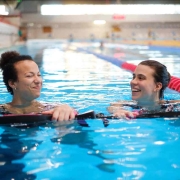How Can I Stay Active with Fibromyalgia Without Overdoing It?
Living with fibromyalgia can present unique challenges, especially when it comes to staying active. It is not uncommon for people with fibromyalgia to feel nervous about exercising because they are scared about making the pain worse. However, in reality, exercise can help those living with fibromyalgia.
Research shows that individuals with fibromyalgia who exercise routinely can enjoy the following benefits:
- Less pain & fewer tender points
- Improved ability to do daily tasks
- Reduced stress levels
- More energy
- Better sleep
- Less stiffness
- Improved mental health
If you have fibromyalgia, you can safely participate in regular, appropriate exercise without worsening your symptoms. The trick is finding the right balance between staying active and not overdoing it.
Here are a few tips on how to stay active with fibromyalgia safely and effectively.
1 – Choose Suitable Exercises
Not all exercises are created equal, especially when it comes to fibromyalgia. Consider low-impact activities that are gentle on the joints and muscles. This includes activities such as walking, swimming or water aerobics, or yoga. These exercises can improve cardiovascular health, flexibility and strength without putting excessive strain on your body. They also reflect exercises that can be started for those at any fitness level.
2 – Build Up Your Exercise Tolerance
With any exercise, the goal is to start slowly and gradually increase the intensity and duration of your workouts. For example, begin with short sessions of 10-15 minutes a few times a week. Gradually extend the duration of exercise as your tolerance improves. Listen to your body throughout this process and don’t push yourself too hard, especially when symptoms are flaring up.
3 – Exercise with Breaks
Break up your exercise routine into shorter segments with rest periods in between. For example, instead of trying to complete a 30-minute walk at one time, divide it into three 10-minute walks spread throughout the day. This approach can help prevent overexertion, help you incorporate exercise into your daily routine, and minimize post-exercise fatigue.
4 – Consult with a Physical Therapist
There is great utility in speaking to a physical therapist before starting any new exercise routine. A physical therapist can teach you proper techniques to prevent injury and optimize the benefits of exercise, and they can give you a program to do at home to regain your strength and flexibility. Our physical therapists specialize in working with fibromyalgia patients and can provide personalized exercise recommendations based on your needs and limitations.
5 – Prioritize Rest and Recovery
Rest is just as important as exercise, especially for individuals with fibromyalgia. Allow yourself adequate time to rest and recover between workouts to prevent burnout and avoid triggering flare-ups.
6 – Stay Hydrated While Exercising
Proper hydration is essential during all forms of exercise. Drink plenty of water before, during and after exercise to stay hydrated and replace fluids lost through sweating. You should also fuel your body with nutritious foods that provide sustained energy and essential nutrients.
7 – Incorporate Exercise into Your Daily Routine (if possible)
Find creative ways to incorporate physical activity into your daily life, even on busy days. Consider taking the stairs instead of the elevator, park farther away from your destination to take extra steps, or do gentle stretches while watching TV. Integrating exercise into your routine makes it more manageable and sustainable over the long term.
8 – Monitor Progress and Adjust Accordingly
This point is crucial if you’re using exercise to reduce the severity of your symptoms. Keep track of your exercise routine, symptoms and progress over time. This will help you identify patterns and make informed adjustments as needed. Use a journal or fitness app to record your workouts, how you feel before and after exercise and any changes in symptoms. Use this information to help identify which exercises are most beneficial and track improvements as you go along. It can also be used as a motivation and goal-setting tool!
9 – Listen to Your Body
This is the most important point. Pay attention to how different activities affect your symptoms and adjust your exercise routine accordingly. If a particular exercise or movement exacerbates pain or fatigue, modify it or try something else. Remember that it’s okay to take rest days when needed and to prioritize self-care.
Incorporating exercise into your life with fibromyalgia can be empowering and beneficial. If you have fibromyalgia and would like help in incorporating physical activity in your life, please give us a call, we can help you. We’ll create a program that considers your goals and your limitations that will help restore balance to your nervous system and improve your symptoms.
References
FREE CONSUMER GUIDE
We think you’ll really like our guide – 18 Things You Should Know Before Selecting a Doctor to Treat Your Fibromyalgia Syndrome.
To receive your copy instantly, click here and fill in the form!









Leave a Reply
Want to join the discussion?Feel free to contribute!